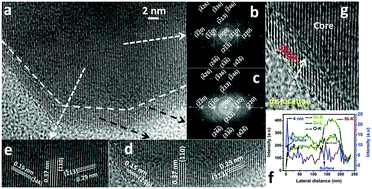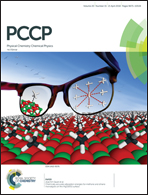Room-temperature ferromagnetism in Ni(ii)-chromia based core–shell nanoparticles: experiment and first principles calculations†
Abstract
We have synthesized bimagnetic core–shell nanoparticles containing a first-of-its-kind Ni(II)-chromia nanophase shell and a well-defined, epitaxial core–shell interface. Magnetic measurements reveal a substantial coercivity of the nanoparticles and a significant exchange bias effect between the antiferromagnetic chromia core and the ferromagnetic Ni(II)-chromia shell at low temperatures. The ferromagnetism and a weak exchange bias effect are found to persist to room temperature in the core–shell nanoparticles of ∼57 nm average size. Our first principles Density Functional Theory (DFT) calculations confirm that the novel corundum-structured Ni(II)-chromia phase has an equilibrium cluster-localized ferromagnetic spin configuration. In addition, the DFT-based calculations show that the Ni(II)-chromia phase is a Mott–Hubbard insulator, with a narrowed energy band gap and increased covalent bonding due to strong hybridization between Ni 3d and O 2p levels in the upper portion of the valence band and within the band gap region. The antiferromagnetic, ferromagnetic and magnetoelectric properties of our core–shell nanoparticles make these well suited for patterned recording media and biomedical applications.



 Please wait while we load your content...
Please wait while we load your content...
